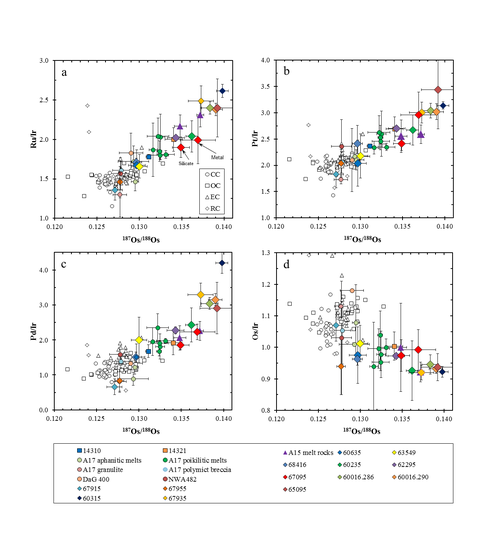2014 Annual Science Report
 NASA Goddard Space Flight Center
Reporting | SEP 2013 – DEC 2014
NASA Goddard Space Flight Center
Reporting | SEP 2013 – DEC 2014
Fingerprinting Late Additions to the Earth and Moon via the Study of Highly Siderophile Elements in Lunar Impact Melt Rocks
Project Summary
During this funding cycle we completed work on abundances of highly siderophile elements (HSE) and Os isotopes in Apollo 17 impact melt rocks. The results were woven into a manuscript by UMd Ph.D. student Miriam Sharp. The resulting large database for impact melt rocks from this site is consistent with a dominant signature imparted to rocks from a single major impactor. The inferred composition of this impactor was broadly chondritic with respect to HSE, but characteristically enriched in 187Os/188Os (proxy for long-term Re/Os), Ru/Ir and Pd/Ir, relative to most chondrites that have been analyzed for these elements. The characteristics of the dominant impactor are most similar to chondritic meteorites that are relatively poor in organics and volatiles (e.g., enstatite chondrites), and so the formation of the spatially associated Serenitatis basin was likely not a process that delivered substantial water and/or organics to the lunar crust. These results were published in Sharp et al. (2014).
Project Progress
The combined results of our Apollo 14, 15, 16 and 17 impact melt rocks studies we have conducted (since 2008) can be interpreted as evidence for the involvement of at least three chemical types of impactors. However, the new Apollo 16 data coupled with published data for Apollo 14, 16 and 17 melt rocks, as well as some additional data for lunar breccia meteorites, all fall on a more or less linear trend on plots of HSE/Ir versus 187Os/188Os (Fig. 1a-d). This apparently global (at least near side) trend could reflect multiple contributions from early solar system bodies with bulk chemical compositions that range from observed primitive compositions, to compositions not sampled by primitive meteorites present in our collections. Linear trends like these, however, should not be expected to result from contributions derived from a series of impactors with random chondritic compositions. The trend is more consistent with two component mixing. Consequently, the trend may reflect two component mixing of a carbonaceous chondrite like impactor and an evolved metal component. For this interpretation, the geological relations between the rocks suggest that both components were present in the lunar crust before the later-stage, basin-forming events.
A second sub-project, utilizing the isotopic compositions of Ru and Mo isotopes to document the genetics of objects involved in the late heavy bombardment has advanced during the past year. Chemical separation and mass spectrometric techniques have been refined to measure small nucleosynthetic isotopic heterogeneities that are present in early solar system objects and likely transferred to lunar impact melt rocks. Techniques have been refined to a level where we can resolve isotopic anomalies (deviations from terrestrial ratios) of <10 parts per million for both Ru and Mo (two elements characterized by greater than 200 ppm differences for some isotopic ratios among diverse early solar system materials).
Publications
-
Liu, J., Sharp, M., Ash, R. D., Kring, D. A., & Walker, R. J. (2015). Diverse impactors in Apollo 15 and 16 impact melt rocks: Evidence from osmium isotopes and highly siderophile elements. Geochimica et Cosmochimica Acta, 155, 122–153. doi:10.1016/j.gca.2015.02.004
-
PROJECT INVESTIGATORS:
-
PROJECT MEMBERS:
Richard Walker
Project Investigator
Katherine Bermingham
Collaborator
Miriam Galenas
Collaborator
Jingao Liu
Collaborator
Igor Puchtel
Collaborator
Emily Worsham
Collaborator
-
RELATED OBJECTIVES:
Objective 1.1
Formation and evolution of habitable planets.
